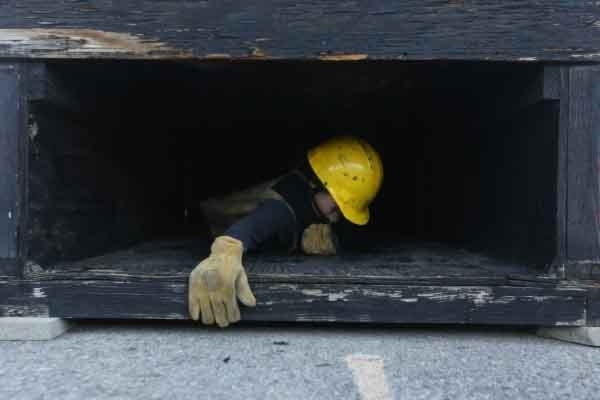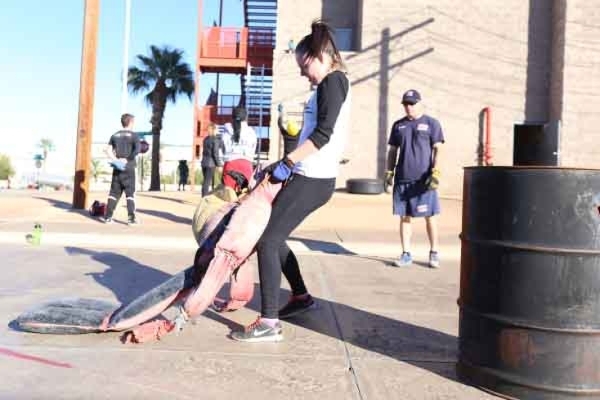Women firefighters often rely on technique over brawn
Battling flames, wearing 50 pounds of gear, and running up and down burning buildings may not be every little girl's dream, but the notion of becoming a damsel in distress is also growing out of style.
In the Las Vegas Valley, women are challenging the standards that firefighters have to be tall, muscular men. Instead, they use their wits, brains and other techniques to serve their community.
"Becoming a firefighter isn't a traditional role that women take, but they absolutely can do it," said Henderson Fire Captain Kim Moore. "You need to be thick-skinned at times, have a lot of dedication and have the desire to take care of people in their time of need. You won't get anything handed to you just because you're a girl. It takes hard work and strength."
Moore became inspired to enter the field by her father, who worked as a firefighter for 19 years in North Las Vegas.
At 5-foot-3-inches tall, Moore worked as a dispatcher and EMT at MERCY Ambulance before entering paramedic school and interning under Henderson Fire Department Battalion Chief Doug Koopman, who she said inspired her to enter the field.
She initially failed the physical test, but she passed the second time and was hired as one of Henderson's first female firefighter paramedics in 1995.
Moore was promoted to engineer during Christmas of 2000, and seven years later, she was promoted again to the city's fire captain.
"You have to be at the top of your game and know what's going on because you compete right along with all of the guys," Moore said. "The first time I tested as captain, I was not selected, and it burns, but I didn't feel like they were being biased. They just want the best candidates for the job."
Nationwide, women firefighters have filed a number of suits alleging sexual harassment or gender bias in promotions. Moore said she's never experienced any sexual harassment.
Henderson spokeswoman Kathleen Richards said promotions in the fire department are tough to come by because there's not a lot of vertical movement in the field compared to other industries.
"In the Clark County Fire Department, as many as 1,000 people have applied to be a firefighter when we only had 20 openings in previous years," said Tim Szymanski, the department's spokesman. "The number of openings varies as well as people applying, but there is always a significant number of people that apply."
Because firefighters work 24-hour shifts and sleep in a dorm by the kitchen with little to no privacy, it can be an uncomfortable situation, but Moore said it helps form a close bond.
"We're right next to the stinky boys who are snoring," Moore said. "I don't mean to make it sound like a cliche, but these are truly like my brothers. We're a family. We tease each other all of the time."
There's also the emotional aspect of the job, which can affect anyone, regardless of gender.
"The hardest moments I've faced were the individual calls I couldn't help," Moore said. "It's difficult to see a child who's not breathing on the floor or see someone with blood everywhere, but we're there to do a job and work with the patient."
Jacqueline Palmer, 37, a firefighter at the Las Vegas Fire and Rescue Station 10, became a firefighter by chance.
At 26, while working as a guide for Pink Jeep Tours, she was refueling her vehicle when she saw a fire engine pull up. The following day, she found out that the city was hiring, and she made the leap toward a new career.
"My whole life was geared toward becoming a basketball coach or athletic trainer," said Palmer, who has a master's degree in sport psychology. "The first time I touched fire equipment was during the actual test. I had no plans to become a firefighter, but I just fell in love with it. I like the challenge."
Palmer passed the test on her first try at 27. Perhaps the most challenging part is the Candidate Physical Ability Test. It may seem that the physical aspect of the training regime favors men over women; however, Palmer doesn't see it that way.
"The test doesn't weed out women; it weeds out people who aren't strong enough," Palmer said. "It's very close to what the job is, so if you can't pass the test, then you can't do the job.
"I know I'm not as strong as the men are, and I know I have to work harder, but that's on me because this is the job that I chose to do. I don't weight as much, and I don't have as much upper body strength, so I have to compensate for that with different techniques."
Palmer admits that pursing a career largely dominated by men who are "mostly Type A personalities" can be intimidating.
"People need to get past the stereotype that women can't work out or shouldn't work out," Palmer said. "Women can absolutely do this type of work if they put their mind to it. The biggest thing is the mentality to not quit. When working in a fire, it's hard; it's hot and uncomfortable, but you have to keep working beyond your exhaustion point. Normal people, when they get tired, they stop, but we have to be able to not pay attention to that and work beyond."
Jasmine Ghazinour, 35, became a firefighter after following in her mother's footsteps.
"My mom volunteered in the fire service department, and I thought 'why not get paid to do something she loved?' It was a bonus for me," Ghazinour said.
She took the firefighter test at age 27 with a broken right arm and passed.
"I weighed 125 pounds, and I got through it with a broken arm," Ghazinour said. "If I can do it, anyone can do it, not just males. I think people think of firefighters as looking like those bulky guys in the firefighter bachelor calendars who weigh 250 pounds, but anyone can be a firefighter. It's like anything in life: You just have to work hard at it."
Ghazinour, a mother of two, said female firefighters could be put on desk and office duties during pregnancy.
A good way to explore if firefighting is the right career choice is to do what Henderson firefighter Bridgette Cota did and join the fire department's Explorer Program, designed for youths 16 to 21 to participate in fire ground skills, academic studies, team-building exercises and ride-alongs.
"The program trained me really well for the academy," Cota said. "I already knew what to expect during the physical training and what areas to work on. Now that I'm a firefighter, I feel like I have hundreds of older brothers and father-like figures."
Las Vegas Valley female firefighter statistics break down as follows:
— The Henderson Fire Department has 244 full-time staff members, with 208 working in fire and rescue operations; and 20 of the 244 are women. Currently, there are four women firefighters in the department with a soon-to-be fifth graduating from the cadet academy.
— Out of the 250 people interviewed for its current academy, the Henderson Fire Department hired 17, according to Richards.
— The first female firefighter was hired in 1987.
— The Las Vegas Fire Department has 705 full-time staff members, including 85 full-time female employees and 620 full-time males. Currently, there are 28 full-time female firefighters and 544 male firefighters.
— The first female fire inspector, Jeanne Schmitz, was hired on June 6, 1971, and the first female firefighters hired were Ellen Goldsmith, Linda Curtin and Diane Moyes on April 22, 1985. Moyes went on to become the first female battalion chief for Las Vegas Fire and Rescue, according to Szymanski.
— The Clark County Fire Department has 684 full-time staff members, including 40 full-time female employees and 644 full-time males. Currently, there are 621 24-hour firefighting personnel, excluding command staff, which consists of 18 full-time female firefighters and 603 male firefighters.
— From 2008 to 2012, roughly 3.8 percent of paid firefighters in the U.S were women, according to the National Fire Prevention Association's website, nfpa.org. The 2010 U.S. Census put that number at 4.8 percent.
Testing to become a Nevada firefighter consists of a written examination, physical ability test, oral board interview, medical exam, background check and suitability exam.
"I think females bring a different perspective to the job," Cota said. "We have a different way of relating to patients. At the end of the day, the gratitude we receive from the community we serve makes all of our training and hard work worth it. It's definitely a rewarding job."
— To reach North View reporter Sandy Lopez, email slopez@viewnews.com or call 702-383-4686. Find her on Twitter: @JournalismSandy.
Recruitment drive
The Clark County Fire Department and the fire departments of Henderson, North Las Vegas, Mesquite, Mount Charleston and Pahrump are having a recruitment drive through Dec. 22. It is limited to the first 4,500 applicants. Information about minimum qualifications for each agency, testing dates and other pertinent information about the recruitment effort is available at snvfirerecruitment.com.


















